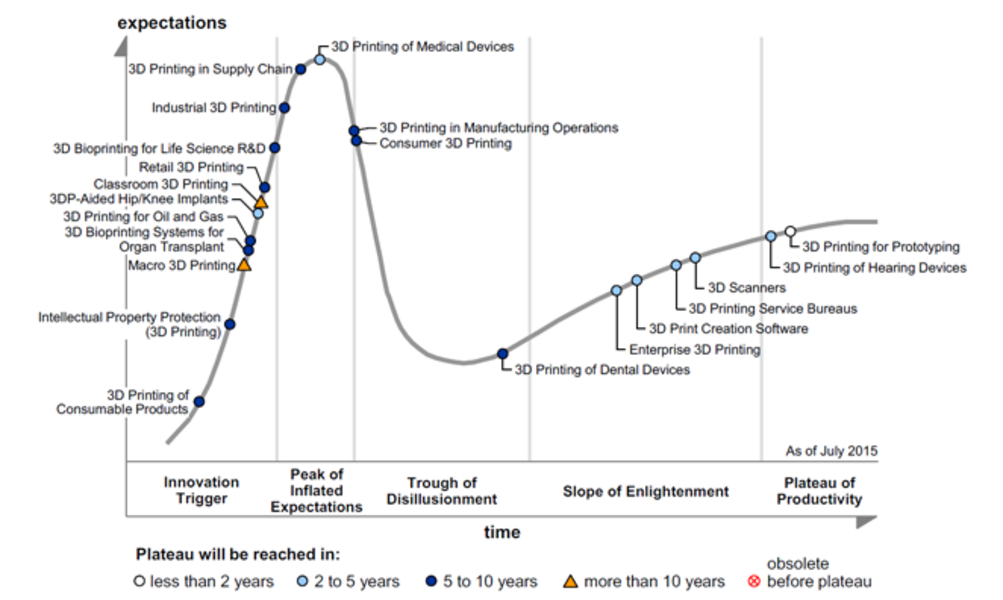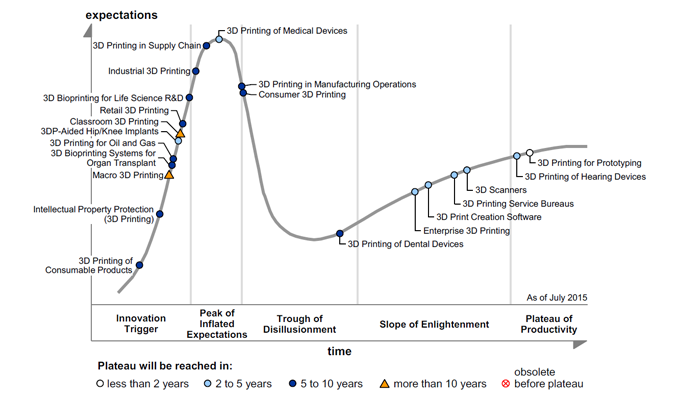The 3D printing Hype Cycle by Gartner: What does the 2017 edition say?
Posted By Amandine Richardot on Aug 1, 2017 | 0 comments
Gartner has recently published its 2017 edition of the 3D printing Hype Cycle. If you’re not familiar with this great tool, it’s an annual study focussing on the main 3D printing trends, based on Gartner’s Hype cycle, a graphic representation of the adoption and maturity of a technology. Gartner’s Hype Cycle for 3D printing is truly helpful for your business strategy if you work in the 3D printing field.
According to Gartner’s Hype Cycle, there are 5 different steps for a trend: being on the rise, being at its peak of expectations, sliding into the through, climbing the slope of enlightenment and finally entering the plateau of productivity. Today, let’s check at which part of their journey the different 3D printing trends are.
1. On the rise
A trend that is on the rise is starting to get a lot of interest due to its high potential. Most of the time, no usable product exists, only proofs of concept or relevant research. These definitely are the trends to watch in the coming months and years, due to how they could drastically change things regarding 3D printing.
Here are the trends that are currently on the rise according to Gartner’s Hype Cycle for 3D printing:
- 3D printing workflow software
- 3D printing of consumable personal products
- 4D printing
- Nanoscale 3D printing
- 3D printed wearables
- 3D printed drugs
- 3D bioprinted organ transplants
- Intellectual property protection in 3D printing
- Macro 3D printing
- Sheet lamination
- 3D printing in oil and gas
All of these trends and technologies definitely have a high potential. They clearly show the global life-changing power of 3D printing, either for consumable personal products, for clothing, for health, or for energy. We actually already foresaw quite a lot of them.
For instance, 3D printing workflow software clearly is a huge upcoming trend, that’s why at Sculpteo we already developed in-house 3D printing software tools that you can discover in some of our previous blog posts. Fashion could also be strongly impacted by 3D printing since it can allow many new creative possibilities. For more information on 3D printing for fashion, discover our previous blog post. Moreover, health is also strongly impacted by 3D printing. The upcoming revolution would be to 3D print organs and other complex parts of the body thanks to bioprinting. For now, researchers have already found a way to 3D print bones.
2. At the peak of expectations
A trend that is at this peak is at the moment when expectations regarding it are the highest. There already are some success stories with it. But it’s not commonly adopted yet.
Here are the 3D printing trends that are currently at their peak of expectations:
- Powder bed fusion
- 3D printing in retail
- Classroom 3D printing
- Directed energy deposition
- 3D printed surgical implants
- 3D printing in Supply chain
- 3D bioprinting for life science R&D
As you can see, 3D printing is conquering more fields, either retail, education, supply chain and life science research and development. And expectations are high regarding how 3D printing could impact them. Great innovations also create high hopes, both technically and in terms of impact, like 3D printed surgical implants, as our customer Spine Vision.
3. Sliding into the through
This step corresponds to the moment where there is a wave of disillusion about a 3D printing trend. Most of the time, experiments and implementations fail, and people tend to think that the high potential that was seen can’t actually become a true reality. But most of the time, it’s only momentary.
Here are the 3D printing trends that are currently at this step of Gartner’s Hype Cycle:
- 3D printing of medical devices
- 3D bioprinted human tissue
- Consumer 3D printing
- 3D printing in manufacturing operations
- 3D printing in aerospace and defense
- Stereolithography
- 3D printed presurgery anatomical models
- 3D printed tooling, jigs, and fixtures
- 3D printed electronics and fabrications
Even if these 3D printing trends tend to be seen as experiencing difficulties, most of these topics still have a high potential, especially 3D printing medical devices, 3D printing human tissue, using 3D printing for aerospace, for tooling, and for electronics.
4. Climbing the Slope of enlightenment
Trends that are climbing the slope of enlightenment start to be more widely understood and used. Second and third generation products start to appear on the market, being more performant and satisfying for the customers. Conservative companies remain cautious though.
Here are the trends that are currently climbing this slope of enlightenment of the 3D printing hype cycle:
- 3D printing of dental devices
- Binder Jetting
- Material Jetting
- 3D printing in automotive
- Entreprise 3D printing
- Material extrusion
- 3D scanners (See our map!)
- 3D printing creation software
- 3D printing service bureaus
Since we launched our new material, Binder Jetting Stainless Steel, we couldn’t agree more with its position on this 3D printing hype cycle! It offers a wide range of possibilities for metal 3D printing, at a competitive price. We also couldn’t agree more with the professionalization of the market, as described with the other 3D printing trends that were chosen. The shift from B2C 3D printing to B2B 3D printing is clearly here to stay, and it shows that the 3D printing market is becoming more mature. To learn more about this, discover our annual report, The State of 3D printing, which explains to you the evolutions of the 3D printing field.
5. Entering the plateau of productivity
Finally, a trend that is entering the plateau of productivity is at a moment where it starts becoming mainstream and widely adopted.
Here are the 3D printing trends that reached Gartner’s plateau of productivity:
- 3D printing for prototyping
- 3D printing of hearing devices
These results are not surprising. Indeed, 3D printing was first used for prototyping. But this technology can do so much more, as demonstrated with the previous trends. It is becoming more and more a manufacturing method. For instance, 3D printing is used to produce custom-made hearing devices, as explained in one of our previous blog posts. Interestingly, there are not a lot of trends in this category, showing that there is still a high innovation potential for the future in the field of 3D printing.
For more insights on the world of 3D printing in 2017, you can also discover our annual report The State of 3D printing. You will discover many insights on this technology, its use, and its high potential. Download the survey now!


 Connect with Google
Connect with Google Connect with Facebook
Connect with Facebook
